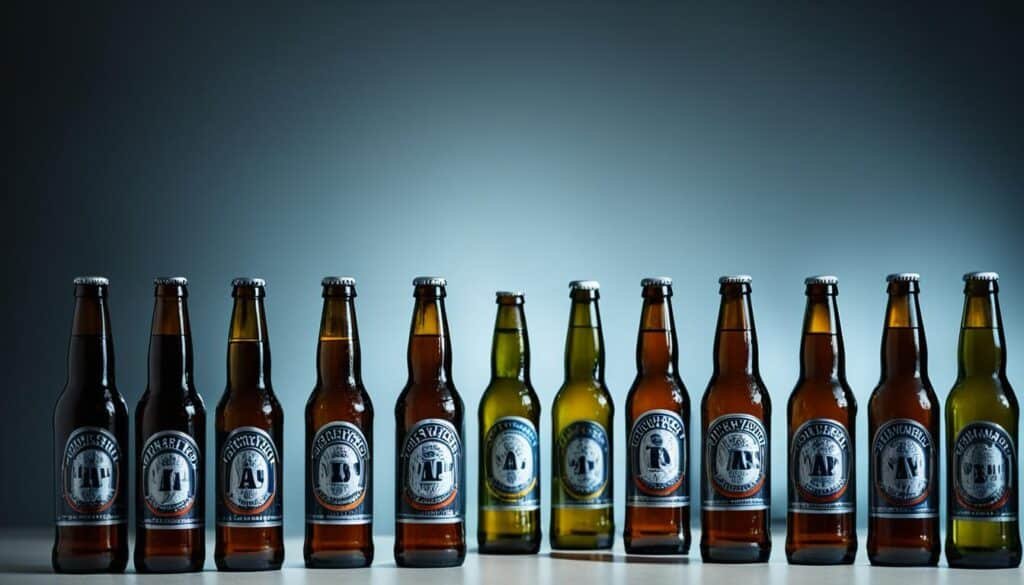The question of “Is 7 beers a day too much?” is a critical one in the realm of public health discussions. In the United States, the Dietary Guidelines provide a clear benchmark, suggesting that women limit alcohol consumption to no more than one drink per day, and men to no more than two. Routinely consuming seven beers daily not only surpasses these guidelines but sets the stage for a spectrum of health risks. The health risks of drinking excessively are well-documented, encompassing liver damage, increased chances of alcohol abuse, and the potential development of alcohol addiction. Furthermore, the effects of drinking too much alcohol extend beyond personal well-being to include significant societal and relational ramifications.
Understanding what comprises a ‘standard drink’ is essential as container sizes and alcohol by volume (ABV) percentages can be deceptive, leading to unintentional overindulgence. This oversight in daily consumption is concerning, as it can quietly evolve into a pattern of excessive drinking—unchecked and perilous.
Key Takeaways
- US Dietary Guidelines recommend up to 1 drink/day for women and 2 for men, with 7 beers far exceeding these limits.
- Consistently having 7 beers a day can lead to serious health complications and disorders, including AUD.
- Standard drink sizes are often misunderstood, contributing to greater alcohol consumption than intended.
- Even moderate alcohol intake can be harmful for certain individuals and under specific circumstances.
- Heavy and binge drinking patterns are associated with numerous immediate and long-term health risks.
- Distinguishing between average and daily alcohol limits is crucial for responsible consumption and health.
Understanding Alcohol Guidelines and Limits
When discussing responsible alcohol consumption, it’s crucial to have a clear understanding of what constitutes a standard drink and how it varies across different types of beverages. Complications arise when people are misinformed about the alcohol by volume in their drinks, leading some to inadvertently consume more than the daily alcohol limit recommended in the alcohol guidelines.
Defining a Standard Drink
In the United States, a “standard” drink is defined as one that contains about 14 grams, or 0.6 fluid ounces, of pure ethanol. It’s worth noting that the appearance and size of a standard drink can differ wildly based on the type of beverage—one can’t simply rely on the size of the glass or the label on the bottle for an accurate gauge.
A dependable standard drink chart is an essential tool for identifying roughly how much alcohol is being consumed, regardless of the container it comes in. Here’s how different beverages stack up:
| Type of Alcohol | Volume | Typical Alcohol by Volume |
|---|---|---|
| Regular Beer | 12 oz | 5% |
| Table Wine | 5 oz | 12% |
| Distilled Spirits | 1.5 oz | 40% |
A Close Look at Daily Alcohol Limits by Gender
Staying within healthy limits is an important aspect of responsible alcohol consumption. The U.S. Dietary Guidelines suggest keeping alcohol intake at no more than 1 drink per day for women and 2 drinks per day for men. Importantly, these are not averages to be met over a week but rather caps set for any given day, intended to minimize health risks.
Misconceptions About Average Drinking vs. Daily Limits
There’s a common misconception that averaging your drinks over a week is an acceptable practice when it comes to alcohol intake. However, the daily alcohol limit is designed to prevent the accumulation of consumption effects and the increased health risks associated with them. Drinking moderately is not averaging high quantities of alcohol over several days, but rather understanding and adhering to the established guidelines for alcohol consumption.
Is 7 Beers a Day Too Much?
When analyzing the impact of alcohol on health, it’s crucial to put into perspective what constitutes excessive alcohol consumption. With cultural norms varying globally, what some may consider moderate or casual drinking might actually fall under seriously detrimental behaviors leading to alcohol-related health consequences.
The Reality of Excessive Alcohol Consumption
Regularly consuming seven beers a day is far beyond the threshold of what health authorities define as safe or moderate. This level of intake is firmly within the realm of excessive alcohol consumption, and though it may not necessarily lead to an immediate diagnosis of alcohol use disorder, it paves the way for a multitude of risks to physical and mental health.

Comparing Consumption with Dietary Guidelines
If we compare this frequency of drinking with the dietary guidelines advised by health professionals, the disparity is alarming. Those guidelines are in place to safeguard individuals from the insidious onset of alcohol-related health consequences, emphasizing much smaller quantities as part of a safe lifestyle. The consumption of seven beers daily is not just a slight overshoot of these recommended levels; it is a stark contrast, reflective of an ingrained pattern of drinking that may lead to serious health issues.
Patterns of Drinking: Binge vs. Heavy Drinking
Understanding the difference between binge drinking and heavy drinking is pivotal. Binge drinking is categorized by the National Institutes of Health as a pattern of drinking that brings blood alcohol concentration levels to 0.08 g/dL. This typically occurs after men consume 5 or more drinks or women consume 4 or more drinks in about 2 hours. Heavy drinking, on the other hand, is defined as more than 15 drinks per week for men or 8 for women. Seven beers a day falls into both categories, highlighting a serious cause for concern regarding patterns of drinking that could cascade into profound, alcohol-related health consequences.
Evaluating the Health Risks of Drinking Too Much Alcohol
Alcohol’s allure lies not only in its capacity to enhance social experiences but also in the perceived respite it offers from life’s stresses. However, inundating our systems with alcohol can have severe repercussions. The gravity and scale of these health risks demand comprehensive examination and understanding. Herein, we diagnose the varied medical concerns one may encounter through excessive alcohol consumption, emphasizing why moderation is not just a recommendation, but a necessity for holistic well-being.
Immediate Health Risks: From Intoxication to Alcohol Poisoning
The most instant effects of drinking too much alcohol manifest as intoxication, a temporary condition, yet not without potential peril. The impairment of coordination and judgment due to intoxication can lead to accidents and injuries—urgent reminders of alcohol’s potent effects on the human body. Moving into the territory of excessive indulgence, we encounter alcohol poisoning; an acute medical emergency that stems from high levels of alcohol in the bloodstream, which can be life-threatening and requires immediate medical attention.
Long-Term Consequences: Chronic Diseases and Mental Health
Tracing the trajectory of continued alcohol abuse, we cross paths with chronic diseases such as liver cirrhosis, cardiovascular diseases, and an increased risk of certain cancers, all of which constitute formidable health risks of drinking. Moreover, the toxic relationship between alcohol and mental health is unavoidable, with strong links to mood disorders, anxiety, and the possibility of early-onset dementia. The effects of drinking too much alcohol often transcend physical boundaries, infiltrating the psychological and becoming entrenched within one’s mental well-being.
How Alcohol Affects Different Body Systems
Delving deeper, the systemic impact of alcohol is far-reaching. Regular excessive drinking can compromise digestive health, leading to issues such as gastritis and malnutrition. It can also dampen immune system efficiency, making the body more susceptible to illness. Furthermore, alcohol’s calorie density contributes to obesity, creating a cascade of health concerns. It becomes unequivocally clear that the effects of drinking too much alcohol are not isolated incidents but interlinked catastrophes affecting diverse biological systems within us. Given these sobering facts, reassessing our relationship with alcohol becomes not just prudent, but imperative for those striving for longevity and vitality.
FAQ
Is 7 beers a day too much from a health perspective?
Yes, drinking 7 beers a day is considered excessive and can significantly increase the risk of alcohol abuse, alcohol addiction, and various health problems. The U.S. Dietary Guidelines recommend no more than 1 drink per day for women and 2 drinks per day for men to reduce the health risks associated with alcohol consumption.
What defines a standard drink in the United States?
A standard drink in the U.S. contains about 14 grams or 0.6 fluid ounces of pure ethanol. This typically equates to 12 ounces of regular beer, 5 ounces of table wine, or 1.5 ounces of distilled spirits, although actual drink sizes and alcohol content can vary.
What are the daily alcohol limits recommended by gender?
The daily alcohol limits recommended by the U.S. Dietary Guidelines are no more than 1 standard drink per day for women and 2 standard drinks per day for men. Consuming in excess of these limits can increase the risk of alcohol-related issues.
What are some common misconceptions about average drinking versus daily limits?
A common misconception is that daily limits can be averaged over several days, but this can lead to unhealthy drinking patterns. It’s important to understand that daily limits are set to mitigate risks each day and not to be averaged across multiple days which could result in excessive consumption.
How does consuming 7 beers a day compare with the U.S. Dietary Guidelines?
Consuming 7 beers a day far exceeds the U.S. Dietary Guidelines for alcohol consumption. Such a level of intake significantly heightens the risk of developing alcohol-related health problems compared to following the recommended limits of 1 drink per day for women and 2 for men.
What are the differences between binge drinking and heavy drinking?
Binge drinking is defined as consuming 4 or more drinks for women, or 5 or more drinks for men, in about 2 hours. Heavy drinking is consuming more than 8 drinks per week for women or 15 drinks per week for men. Both patterns are problematic, but drinking 7 beers a day would be classified as heavy drinking and intensifies the risk of alcohol use disorder and other consequences.
What are the immediate health risks associated with drinking too much alcohol?
Immediate health risks of drinking too much alcohol include intoxication, impaired judgment leading to accidents or injuries, and alcohol poisoning, which can be life-threatening. These immediate risks are accompanied by a higher likelihood of engaging in risky behaviors and experiencing social consequences.
What long-term consequences can arise from chronic excessive alcohol consumption?
Long-term consequences of chronic alcohol abuse include an increased risk of developing chronic diseases such as liver disease, heart disease, several types of cancer, and hypertension. It also greatly impacts mental health, potentially contributing to anxiety, depression, and early-onset dementia.
How does excessive alcohol consumption affect different body systems?
Excessive alcohol consumption can adversely affect various body systems, leading to gastrointestinal issues, malnutrition, weakened immune function, and obesity. It can also affect the central nervous system, contributing to mental health issues and cognitive decline over time.
